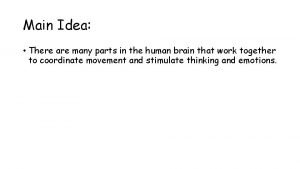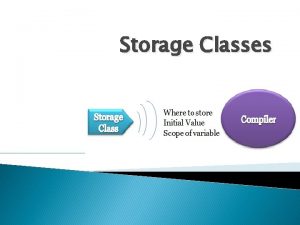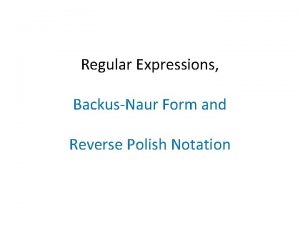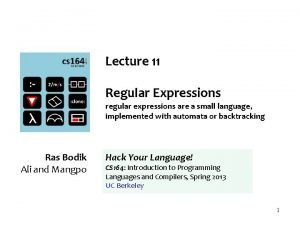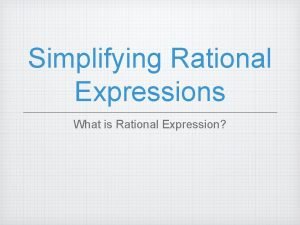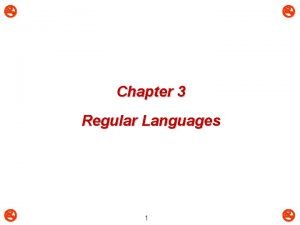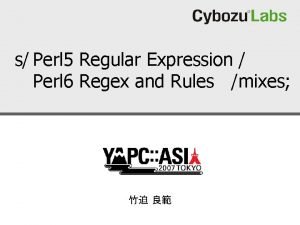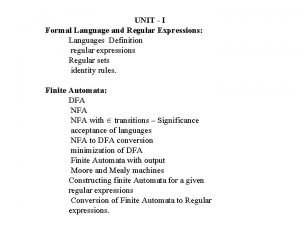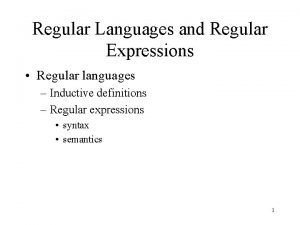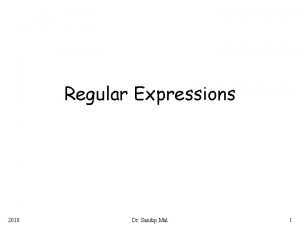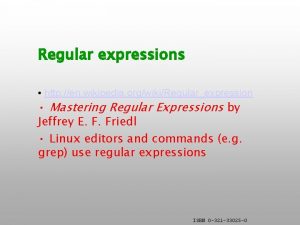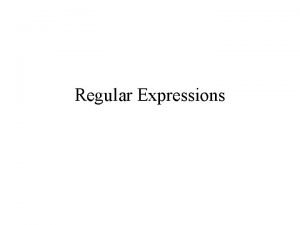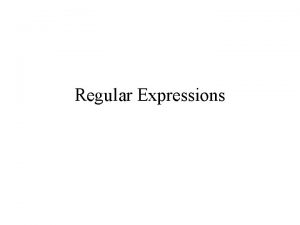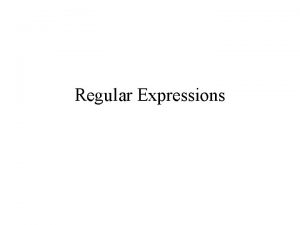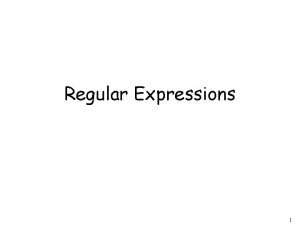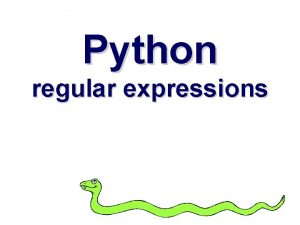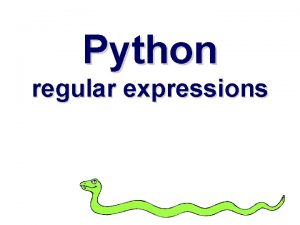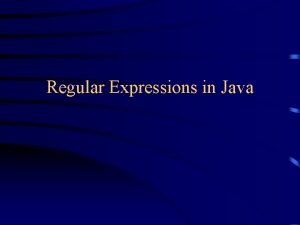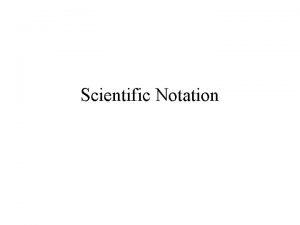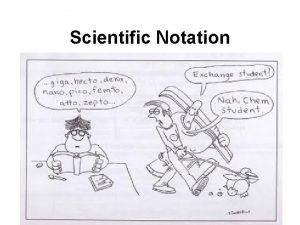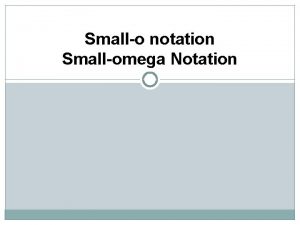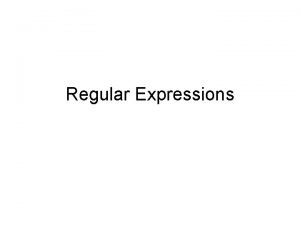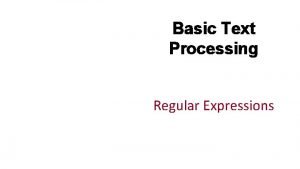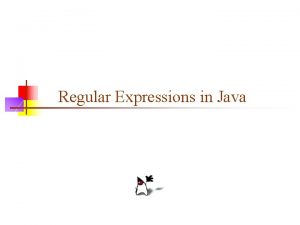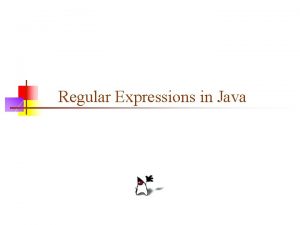Regular Expressions Regular Expressions Notation to specify a
























- Slides: 24

Regular Expressions

Regular Expressions • Notation to specify a language – Declarative – Capable of describing the same thing as a NFA • The two are actually equivalent, so RE = NFA = DFA – We can define an algebra for regular expressions

RE Examples • • L(001) = {001} L(0+10*) = { 0, 1, 100, 10000, … } L(0*10*) = {1, 01, 10, 0010, …} i. e. {w | w has exactly a single 1} L((0(0+1))*) = { ε, 00, 01, 0000, 0001, 0100, 0101, …} L((0+ε)(1+ ε)) = {ε, 0, 1, 01} L(1Ø) = Ø ; concatenating the empty set to any set yields the empty set. R+Ø = R • Note that R+ε may or may not equal R (we are adding ε to the language) • Note that RØ will only equal R if R itself is the empty set.

RE Exercise • Exercise: Write a regular expression for the set of strings that contains an even number of 1’s over ={0, 1}. Treat zero 1’s as an even number.

Equivalence of FA and RE • Finite Automata and Regular Expressions are equivalent. To show this: – Show we can express a DFA as an equivalent RE – Show we can express a RE as an ε-NFA. Since the ε-NFA can be converted to a DFA and the DFA to an NFA, then RE will be equivalent to all the automata we have described.

DFA to RE: State Elimination • Eliminates states of the automaton and replaces the edges with regular expressions that includes the behavior of the eliminated states. • Eventually we get down to the situation with just a start and final node, and this is easy to express as a RE

State Elimination • • Consider the figure below, which shows a generic state s about to be eliminated. The labels on all edges are regular expressions. To remove s, we must make labels from each qi to p 1 up to pm that include the paths we could have made through s. Note: q and p may be the same state!

DFA to RE via State Elimination (1) 1. Starting with intermediate states and then moving to accepting states, apply the state elimination process to produce an equivalent automaton with regular expression labels on the edges. • The result will be a one or two state automaton with a start state and accepting state.

DFA to RE State Elimination (2) 2. If the two states are different, we will have an automaton that looks like the following: We can describe this automaton as: (R+SU*T)*SU*

DFA to RE State Elimination (3) 3. If the start state is also an accepting state, then we must also perform a state elimination from the original automaton that gets rid of every state but the start state. This leaves the following: We can describe this automaton as simply R*.

DFA to RE State Elimination (4) 4. If there are n accepting states, we must repeat the above steps for each accepting states to get n different regular expressions, R 1, R 2, … Rn. For each repeat we turn any other accepting state to non-accepting. The desired regular expression for the automaton is then the union of each of the n regular expressions: R 1 R 2… RN

DFA RE Example • Convert the following to a RE • First convert the edges to RE’s:

DFA RE Example (2) 0+1 0 • Eliminate State 1: Start 3 1 1 1 2 0 • To: Note edge from 3 3 Start Answer: (0+10)*11(0+1)* 0+10 3 11 2

Second Example • Automata that accepts even number of 1’s 0 0 Start 1 1 • Eliminate state 2: 1 1 3 1 0+10*1 0 Start 2 0 10*1 3

Second Example (2) 0+10*1 0 Start 1 10*1 3 • Two accepting states, turn off state 3 first 0+10*1 0 Start 1 10*1 3 This is just 0*; can ignore going to state 3 since we would “die”

Second Example (3) 0+10*1 0 1 Start 10*1 3 • Turn off state 1 second: 0+10*1 0 Start 1 10*1 3 This is just 0*10*1(0+10*1)* Combine from previous slide to get 0* + 0*10*1(0+10*1)*

Converting a RE to an Automata • We have shown we can convert an automata to a RE. To show equivalence we must also go the other direction, convert a RE to an automaton. • We can do this easiest by converting a RE to an εNFA – Inductive construction – Start with a simple basis, use that to build more complex parts of the NFA

RE to ε-NFA • Basis: a R=ε ε R=Ø Next slide: More complex RE’s


What have we shown? • Regular expressions and finite state automata are really two different ways of expressing the same thing. • In some cases you may find it easier to start with one and move to the other – E. g. , the language of an even number of one’s is typically easier to design as a NFA or DFA and then convert it to a RE

Algebraic Laws for RE’s • Just like we have an algebra for arithmetic, we also have an algebra for regular expressions. – While there are some similarities to arithmetic algebra, it is a bit different with regular expressions.

Algebra for RE’s • Commutative law for union: –L+M=M+L • Associative law for union: – (L + M) + N = L + (M + N) • Associative law for concatenation: – (LM)N = L(MN) • Note that there is no commutative law for concatenation, i. e. LM ML

Algebra for RE’s (2) • The identity for union is: – L+Ø=Ø+L=L • The identity for concatenation is: – Lε = εL = L • The annihilator for concatenation is: – ØL = LØ = Ø • Left distributive law: – L(M + N) = LM + LN • Right distributive law: – (M + N)L = LM + LN

Laws Involving Closure • (L*)* = L* – i. e. closing an already closed expression does not change the language • Ø* = ε • ε* = ε • L+ = LL* = L*L – more of a definition than a law • L* = L+ + ε
 Specify which part of the brain includes calliculis
Specify which part of the brain includes calliculis Reactive risk strategies in software engineering
Reactive risk strategies in software engineering A systematic attempt to specify threats to the project plan
A systematic attempt to specify threats to the project plan Dimensions in research
Dimensions in research How many codons are needed to specify three amino acids?
How many codons are needed to specify three amino acids? 10 pillars of islam
10 pillars of islam List the primitives that specify a data mining task.
List the primitives that specify a data mining task. Data mining functionalities with examples
Data mining functionalities with examples If you don't specify a storage class for a variable
If you don't specify a storage class for a variable Systematic attempt to specify threats to project plan
Systematic attempt to specify threats to project plan A systematic attempt to specify threats to the project plan
A systematic attempt to specify threats to the project plan Postfix to infix conversion
Postfix to infix conversion Reverse regular expression
Reverse regular expression Reverse polish notation
Reverse polish notation Engineering scientific notation
Engineering scientific notation Regular expressions
Regular expressions Site:slidetodoc.com
Site:slidetodoc.com Regular expressions
Regular expressions Regex
Regex I formal
I formal Inductive definition of regular expressions
Inductive definition of regular expressions Primitive regular expressions
Primitive regular expressions Xkcd regexp
Xkcd regexp Regular expressions wikipedia
Regular expressions wikipedia Regular grammars generate regular languages
Regular grammars generate regular languages
